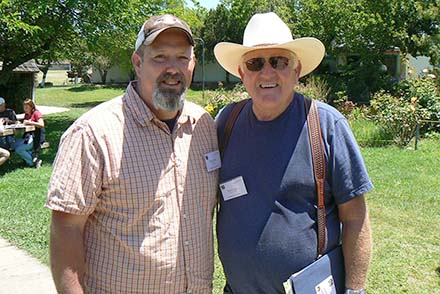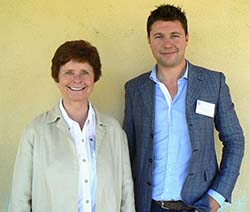
|
|
PRINT » |
|
|
E-MAIL THIS PAGE » |
|
|
CLOSE THIS WINDOW » |
Bring Out the Best in Barbera
Growers and winemakers in California's foothills explain how they optimize Barbera wines

Interest in Barbera was strong here: More than 100 Sierra Foothills growers and winemakers attended the event, organized by Lynn Wunderlich, UC farm advisor for Amador and El Dorado counties. Consumers also were enthusiastic: The Saturday festival, featuring more than 80 California Barbera producers, sold out its allotment of 1,500 consumer tickets two weeks in advance.
Barbera in California
Glenn McGourty, UC extension viticulture advisor for Lake and Mendocino counties (and Wines & Vines columnist) gave an overview and Barbera’s history in California. The cultivar was first planted in 1885 at the Italian Swiss Colony in Asti in northern Sonoma County, and individual Italian-American growers have farmed small acreages of Barbera since the 1890s. It was often in field blends, but varietal Barbera was seldom produced before the 1970s.
Barbera acreage in California peaked at about 20,000 acres in 1980, primarily due to planting encouraged in the San Joaquin Valley by Julio Gallo for use as a blending grape, due to its good productivity, acidity and color. Reported total statewide acreage in 2010 was 6,936 acres, with 6,142 acres still in the San Joaquin Valley.
McGourty observed, “It’s not a coastal grape. It does well in warmer interior locations. It can produce good fruit character, acidity, color and tannin structure.” He said 164 acres are planted in the North Coast, with varietal production by several wineries; Barbera is starting to be recognized as a quality variety in Lake County, and some Central Coast locations offer good potential. The Sierra Foothills AVA has 283 acres planted and has the largest number of varietal producers in the state. McGourty told the region’s producers, “I think this is a variety you can own.”
Barbera clonal choices

Nancy Sweet of Foundation Plant Services (FPS) at UC Davis provided background on the seven registered FPS clones available to U.S. growers.
• FPS 02: Came to FPS in 1983 from Italy. Registered 1988-89. Also known as Rauscedo clone 06.
• FPS 03: Came to FPS in 1993 from CVT-CNR research center in Torino, Italy. Registered 1999-2000. Also known as CVT AT 171.
• FPS 04: Came to FPS in 1993 from CVT-CNR in Torino, Italy. Registered 1999-2000. Also known as AT 84.
• FPS 05: Same selection as FPS 03 (CVT AT 171), but from a different source vine in Italy than FPS 03.
• FPS 06: Originally was FPS 01, also called the Marshall clone. It was first registered in 1970 but then deregistered in 1984 due to leafroll virus. It was retrieved in 1996, cleaned of virus, then registered as FPS 06 in 2000-01.
• FPS 07: Came to FPS in 1998 from Vivai Cooperativi Rauscedo (VCR) in Italy, where it is known as VCR 19. Proprietary to Novavine Nursery, Santa Rosa, Calif.
• FPS 08: Came to FPS in 1998 from VCR in Italy. Known as VCR 15. Proprietary to Novavine.
Sweet described a trial of clones FPS 02 through FPS 06, done by UC Davis cooperative extension viticulture specialist Dr. Matthew Fidelibus at the Kearney Ag Center in Fresno County. From 2003-06, Fidelibus collected data about berry and cluster characteristics, fruit composition and sour rot incidence. Based on San Joaquin Valley growing conditions, he found that FPS 02 is probably the worst choice: It has high susceptibility to sour rot and is late maturing. FPS 06 is the best choice, with the lowest susceptibility to sour rot; it has small berries and the lowest yields.
Fidelibus determined that FPS 04 is the best of the Torino clones, with moderate yields and good fruit composition, but it still is susceptible to sour rot. FPS 03 and 05 had the highest yields and also had excessive sour rot, but they could be a good choice where high yields are desired and sour rot is not a problem.
Italian clones
Diego Barison, director of field operations and customer relations for grapevine nursery Novavine, discussed trials of Barbera clones he has worked with in Italy and California. Barison’s family grows Barbera in Asti, Italy; he earned a master’s degree in viticulture at the University of Turin and has worked at nurseries in France and Italy. Barison said clonal selection of Barbera in Italy involves scouting 50- to 70-year-old vineyards and virus testing potential material. In contrast to FPS, which simply releases clean selections, potential Italian clones are put through winemaking trials, and viticultural characteristics are compared to evaluate and select material prior to release.
More than 50,000 acres of Barbera are planted in Italy. It originated in the Piemonte region but is now planted in several major regions from Piemonte in the north to Campania and Sardinia in the south. Traditionally, Barbera vines were Guyot trained, but most newer plantin
gs are planted on VSP systems at densities of at least 2,000 vines per acre. The most planted rootstock with Barbera in Italy is SO4. On limestone soils, 5BB is used; 1103P is common for dry-farmed vines, and 420A is also used. Italian growers generally plant a mix of clones in their vineyards
Barison said FPS 04 (AT 84) is one of the most planted in Italy, with medium to small clusters, and early to mid-season development and maturity. He called it “a nice, stable clone.” Regarding the two Novavine proprietary clones, Barison said FPS 08 (VCR 15) produces medium-size clusters and berries, has medium vigor and mid-season development for bud break and harvest maturity. Wines produced tend to be stronger and have deep ruby red color if the canopy is properly managed, and the wines can age well.
FPS 07 (VCR 19) produces wine with good body, structure, and color, and tends to have more spicy character. “This is one of the best clones for producing wines for aging,” Barison observed. He is performing trials with other Italian clones in California, and expects more of these to be registered by FPS and available through Novavine in the near future.
Sierra Foothills Barbera production
A panel of Sierra Foothills Barbera growers and winemakers discussed practices, production challenges, and Barbera’s positive qualities. Dick Cooper has grown Barbera since the early 1980s and now has 35 acres in production. He has sold fruit to several award-winning winemakers, notably Jeff Runquist, and also produces wines under the 4,800-case Cooper Vineyards label. The vineyard is mostly clone 06 on 110R and St. George rootstocks. All vines are head-trained with vertical cordons, and with 22 spurs at maturity. Target yields are 4.5 tons per acre.
Cooper said Barbera can be frost sensitive and prone to powdery mildew. He likes to prune by January, otherwise growth and maturity can be delayed. This does increase the risk to damage from spring frosts; he has wind machines for frost protection. He observed, “If frost damage occurs, leave the vines alone and 50% of the crop will come back.”
Most years, no irrigation is needed before mid-July, but Barbera can quickly show signs of water stress. “If the temperature reaches 100ºF, turn on the drip irrigation immediately,” Cooper warned. Barbera tends to grow with small leaves and a low-density canopy. Cooper said, “We never pull leaves, and we pick when total acidity is below 1 g/L.”
Kevin Steward has managed Trinchero Family Estates vineyards in Amador County for 12 years, the largest area grower of Barbera with 70 acres for the 220,000-case Terra d’ Oro/Montevina labels. Training and trellis systems manage vigor and quality. Barbera was originally on bilateral trellising, then was switched to a quadrilateral system with spur pruning that improved quality. A 5-acre block was changed to a quad system with cane pruning; Steward believes this is producing the best quality Barbera. He said, “Vigor control is important. We use cover crops, and dwarf triticale is the best for pulling excess soil moisture. We also do crop thinning if needed.” Yield target is 4.5 to 5 tons per acre, which also provides the desired acid level.
Ann Kraemer is a newer Barbera grower who began planting in 2003 at Shake Ridge Vineyards in southern Amador County for her family’s 2,000 Yorba Wines in Napa. She said, “The challenges of growing Barbera are frost, vigor and acidity.” She has almost six acres in production in two blocks, one with clone 04 on 3309 rootstock, and the other with clone 03 on 110R. To avoid spring frost, she prunes late, commonly in March. This year, pruning was completed in early April, but May temperatures still threatened vines. Vine vigor is partly moderated by the site’s rocky soils, and she employs pruning, minimal irrigation and cover crops to tame vigor. “Our harvest decisions are based on grape flavor and acidity, with the pH target of about 3.40,” Kraemer said. Crop load is kept at 3.5 to 4 tons per acre, as lower yields tend to have too much sugar.
Rusty Folena, winemaker for 10,000-case Vino Noceto uses Barbera from the Linsteadt Vineyard in Amador County, mostly from a newer block with clone 02 on 110R. Folena has worked with Barbera in Amador vineyards for more than 25 years and said, “We don’t have trouble ripening the fruit, but it’s usually the last grape we get at the winery.”
Grapes are picked based on flavor and a total acidity below 1 g/L. Folena said fermentations tend to run cool, never above 85°F., he uses a variety of yeasts, depending on the season. Folena observed, “There is no single or ‘right’ recipe; we have to be flexible in managing wine processing each year.”
Barbera is the flagship wine of 20,000-case Boeger Winery in El Dorado County, accounting for 18% of its varietal case sales in 2010 and 36% of total tons harvested. Winemaker Justin Boeger said Barbera is also commonly used as a base for red wine blends due to its acidity. The winery produced its first varietal Barbera in 1975.
Vineyard sources tod
ay include the 18-acre Ritchie Vineyard, first planted in 1968 with the original clone 01 on its own roots; six acres of estate vineyards planted in 2005 with clone 08 on 3309; and two blocks totaling 10 acres at the leased Stonehouse Vineyard planted in 2007 with clones 04 and 06 on 101-14 and clone 08 on 3309.
Boeger prefers to pick based on pH with a target of 3.30, rather than on TA, which can sometimes be high due to high levels of malic acid that will later be taken care of with malolactic fermentation. Boeger said the wine has “simple fresh fruit characters and good acidity.” He also said, “Barbera is not terribly complex by itself, so we ferment with different yeast strains and sometimes do tannin adjustments to enhance complexity.” He summarized, “I think Barbera is an ideal grape for the Sierra Foothills.”
The winemakers produce 100% varietal Barbera in most vintages. Wines are aged primarily in neutral oak. Boeger uses no more than 10% new oak, and Folena will go as high as 30% new oak. All praised it as a versatile wine for food pairing, and it can appeal to a range of palates with a good acid and fruit balance without excessive tannins. Folena observed, “It’s a well-rounded wine. Consumers who are transitioning in their tastes from sweeter wines and into red wines like the Barberas we produce here.” Kraemer said, “It’s very versatile, it can go with main courses and with salad dressings and fresh tomatoes. It’s a red ‘white’ wine.”
|
|
PRINT » |
|
|
E-MAIL THIS ARTICLE » |
|
|
CLOSE THIS WINDOW » |
